Is your lawn preyed on by damaging insects? We occasionally run into insects that can damage our lawn. So, what can you do to battle these lawn-destroying problems?
Insecticides may be used to control turf insects, sometimes multiple applications may be required.
Insecticides can be used preventatively coinciding with when an insect's occurrence is likely. Some insecticides are more costly than others but offer long residual activity giving a much bigger window to prevent outbreaks.
If you notice you have any of these issues in your yard, or you're just not sure what it is you're looking for, please give us a call at (478) 200-0650 and we'll be happy to schedule a visit from one of our lawn care specialists.
Armyworms
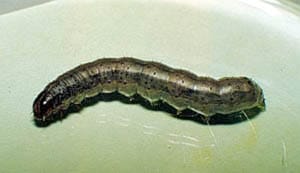
Identification
Armyworms are the larval stage of moths. Their bodies are greenish when small, but become brown when fully grown. Several stripes usually are apparent, extending from the head to the rear. The adult is a mottled brownish-gray moth with a wingspan of nearly 1 ½ inch. Armyworms occur throughout Georgia.
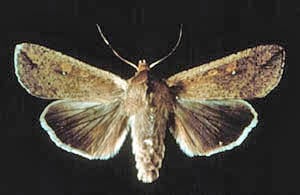
Life Cycle and Biology
Armyworm caterpillars pupate in the soil. The moths emerge within a couple of weeks. They are active mainly at night. Typically three to six generations occur a year in Georgia. Female moths lay clusters of eggs on grass blades, lawn furniture, white or light-colored walls, and other objects near lawns. Caterpillars hatch and begin to feed on the turf.
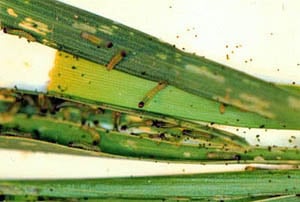
Damage
Damaged turf appears ragged with individual blades showing signs of chewing damage. When numerous, armyworms may devour the grass down to the ground. Young larvae skeletonize grass blades; older larvae feed on entire blades.
Billbugs
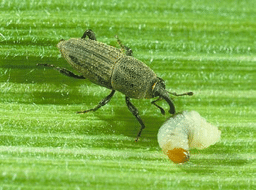
Identification
Adult billbugs are weevils 1/5 to 3/4 inch long. The reddish-brown to black adults have a pair of jaws at the tip of a long snout or “bill’. The young are white, legless grubs about 3/8 inch in length with the rear end wider than the head. The “hunting billbug” is the most common type found in Georgia. It occurs throughout the state.
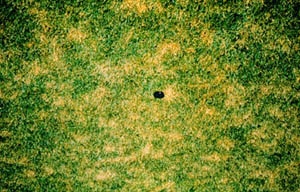
Life Cycle and Biology
Adults feed above ground and deposit eggs in the stems of host grasses. Hatching larvae feed within the stems; larger larvae feed on the crown; mature larvae feed on the roots of the turf. One generation occurs annually, but adults and larvae may be found at any time of year.
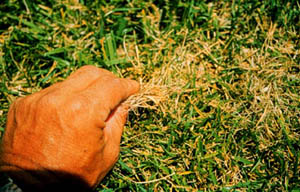
Damage
Zoysiagrass and bermudagrass are most often injured, but feeding may occur on many kinds of grass. When infestations are heavy, roots of the grass are destroyed and the turf is killed in irregular patches. Early damage resembles a dollar spot disease in small spots of dead or dying grass. The most damage occurs in June and July. Damage from billbugs differs from white grub or mole cricket injured turf in that infested soil usually stays firm.

Chinch Bugs
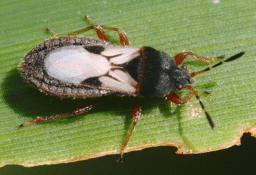
Identification
Adults are about 1/5 inch long and light in color with small black triangular patches on the wings. The wings are carried folded over the back. The nymphs are from 1/20 to 1/5 inch long and vary in color from reddish with a white band across the back to black as they near adult size. Chinch bugs occur throughout the state.
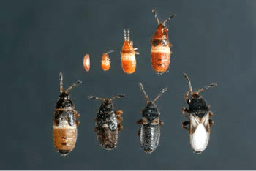
Life Cycle and Biology
The eggs are laid in leaf sheaths or crevices in nodes and other protected places. The young develop into adults in four to six weeks. There are three to four generations a year. The bugs insect their slender beak into the grass and suck the plant juices.
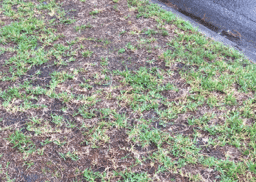
Damage
The typical injury appears as spreading patches of brown, dead grass. St. Augustine grass is the most seriously injured, but other lawn grasses, including Zoysia, Bermuda, Bahia, and Centipede Grasses, also are subject to attack. Chinch bug infestations and damage are most often first noticed during hot dry periods in sunny areas of the lawn.
Cutworms
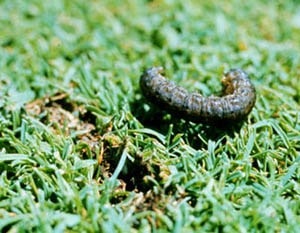
Identification
Cutworms, also the caterpillar stages of certain moths, grow to a length of 1 ½ to 2 inches. The caterpillars are mottled, dull brown, gray, or nearly black and usually appear plump and greasy. If disturbed, the caterpillar usually curls into a C-shaped ball. The front wings of the moth are dark brown to gray, are mottled or streaked, and have a wingspan of 1 ½ to 2 inches. Cutworms also occur throughout the state.
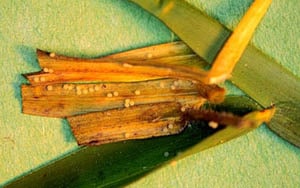
Life Cycle and Biology
Eggs are laid on grass and weed stems or behind the leaf sheath of such plants. Caterpillars usually remain below the ground surface, under clods, or other shelters during the day; they feed at night. Cutworms pupate in the soil. Three to as many as seven generations occur each year. Cutworms can be active all year.
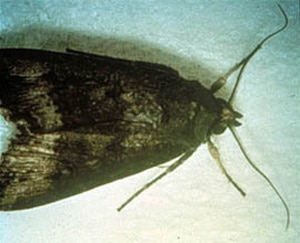
Damage
Foliage or stems may be cut off (hence the name cutworm) by the caterpillars. Circular spots of dead grass or sunken spots are indicative of cutworm infestation.
Mole Crickets
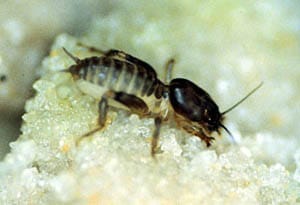
Identification
Mole crickets are light brown, up to 1 ½ inch long, have short, stout forelegs, spade-like feet, and large eyes. The young resemble the adults except that they are much smaller, have no wings, and are sexually immature. Three species occur in Georgia. Two, the tawny mole cricket and the southern mole cricket, are pest species. Mole crickets occur primarily in the sandy soils of the Coastal Plain.
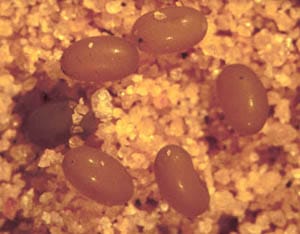
Life Cycle and Biology
Adults lay eggs in underground cells in the spring. The eggs hatch in two to four weeks, depending on the weather. Nymphs feed and grow through the summer and mature into adults in the late fall or winter. Mole crickets spend the winter deep in the soil but come to the surface to feed during warm periods. Adult crickets leave the soil on warm spring nights to fly around, sometimes in huge numbers, looking for mates and egg-laying sites. There is one generation per year, and most adults die by early summer. Tawny mole cricket mating flights occur in March and early April; southern mole cricket flights occur in April and in early May. Cold or wet spring weather may delay flights.

Damage
The most damaging species of mole crickets feed on grass. Other species don’t feed directly on grass, but their tunneling activity damages turf. Both young and adults burrow beneath the soil and make tunnels similar to, but much smaller than, those made by moles. This loosens the soil and causes it to dry out quickly. It also clips the roots of the grass plants. Left unchecked, mole crickets will build up in an area and completely destroy the grass, leaving the bare ground.
Sod Webworms
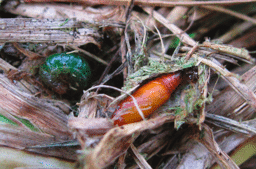
Identification
Sod webworms are caterpillars of small brown to dull gray moths. Webworms grow to a length of nearly 3/4 inch and vary in color from pinkish white to light green to yellowish-brown with a light to dark brown or blackhead. They are covered with fine hairs. The moths have a wingspan of about 3/4 inch. They fold their wings closely about their bodies when at rest and have a prominent forward projection on the head. Sod webworms are found throughout Georgia.
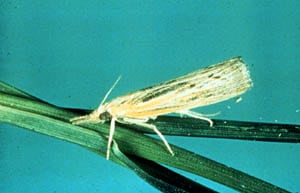
Life Cycle and Biology
Moths hide in shrubbery or other sheltered spots during the day. They fly over the grass in the early evening. The female scatters eggs over the lawns as she flies. Two to three generations occur each year. Sod webworms feed only at night.
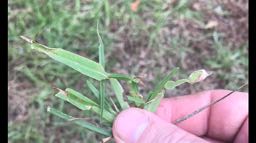
Damage
Damaged grass blades appear notched on sides and are chewed raggedly. Irregular brown spots are the first signs of damage. Large areas of grass may be damaged severely, especially under drought conditions. A heavy infestation can destroy a lawn in only a few days. Damage tends to become visible in mid to late summer and in highly maintained lawns. Sod webworms are partial to newly established lawns. Favored turf types are Bermuda, Centipede, Bahia, Zoysia, and St. Augustine Grasses.
Spittlebugs
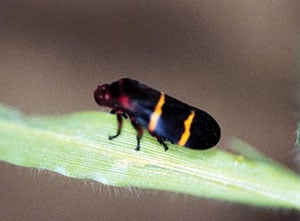
Identification
Spittlebug adults, commonly called froghoppers, are about 3/8 inch long, dark brown or black, and have two orange stripes across their wings. The nymph is ivory-colored with a brown head. Nymphs live inside masses of spittle or froth, hence the name “spittlebug”. They occur throughout Georgia.

Life Cycle and Biology
Adult females deposit orange eggs in bits of hollow stems and other debris. Nymphs hatch in about two weeks and begin to feed immediately by sucking juices from the grass. They cover themselves with a frothy mass know as spittle. There may be one or several nymphs in each spittle mass. The masses are found from just below the soil surface to a few inches above it. Two generations occur annually in Georgia. Overwintering eggs hatch in March and April. This generation reaches maturity by June. Adult activity is also noticeable in August and September, when the second generation matures.
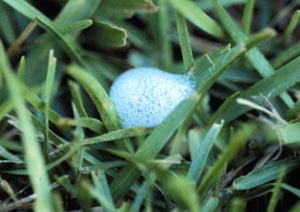
Damage
Spittlebugs are associated with heavy thatch. A heavily infested area will feel “squishy” when you walk across it due to numerous spittle masses. Centipede grass is especially prone to spittlebug infestation; zoysia, bermudagrass, and bahiagrass also are susceptible. Populations often begin and increase in shady areas. The second generation appears to cause more injury. Populations, and therefore, damage, can be especially high during years with high spring and summer rainfall.
White Grubs
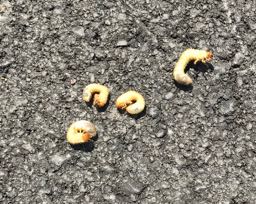
Identification
These grubs are plump, C-shaped insects with three pairs of legs. They are whitish with dark areas near the rear. They have a distinct, brown head. The adults are beetles commonly referred to as chafers, May beetles, June beetles, Japanese beetles or green June beetles. They occur throughout the state of Georgia.
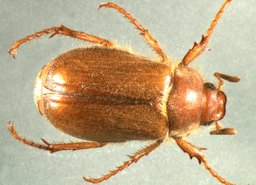
Life Cycle and Biology
Adult female beetles lay their eggs in the soil. The grubs hatch and spend most of their life beneath the soil feeding on underground plant parts. Most have rather long life cycles, The grub stage can last from several months to two or three years. Most species of grubs found in Georgia have a one-year life cycle.
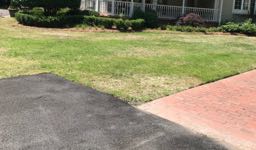
Damage
Grub feeding destroys roots, leaving the tops to wither and die. In heavy infestations, roots are pruned off to the extent that turf can be rolled back like a carpet. Symptoms of grub damage include yellowing or browning of the grass and signs of drought stress when moisture levels are good. The grass may feel spongy when infestations are heavy.
Contact Us For A Free Consultation
"*" indicates required fields
